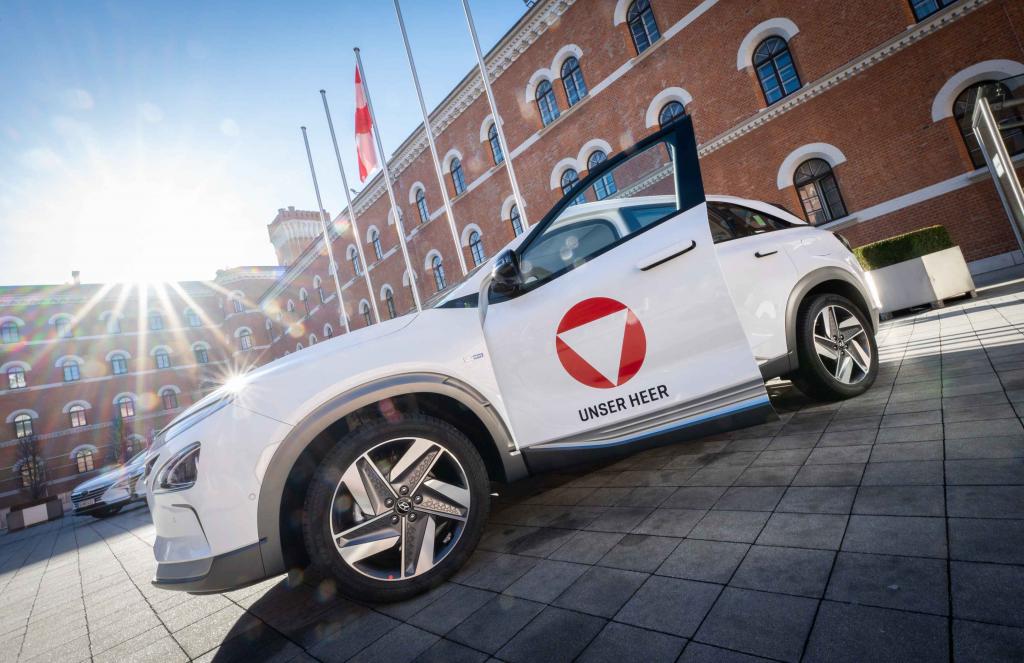Thessaloniki gets ready for its metro launch in November
The underground rapid transit lines have been under construction for almost two decades due to various project delays
 TheMayor.EU logo
TheMayor.EU logo 
The cars are equipped with a hydrogen fuel cell engine that generates electricity by combining hydrogen with oxygen, Source: Bundesheer/Carina KARLOVITS
The vehicles are part of the army’s sustainability strategy for 2024
Yesterday, Austrian Defense Minister Klaudia Tanner handed over five hydrogen-powered cars to representatives of the army. According to a statement by the ministry, this is the next step in the fight against climate change.
Minister Tanner explained in a press release that the federal government’s commitment to reducing CO2 is concrete and it spans all branches of the administration.
She pointed out that, although the hydrogen vehicles were a small step in the right direction, they would still push the army closer to reaching their 2024 sustainability goals.
In terms of government carbon emissions, the army is a serious producer of greenhouse gases, especially considering heavier, fossil fuel-intensive machinery. Finding fuel solutions for military vehicles could have quite a significant impact on CO2 emissions, as well as the public’s perception of what cutting back on pollution means.
This has been on the minds of some EU politicians in recent months, as carbon goals do not exclude the army. Luxembourg, for example, announced a new overarching strategy to make the army more sustainable back in December.
The keys to the vehicles were presented to representatives of the military commands of Vienna, Styria, Upper Austria and Tyrol, as well as to the Ministry of Defence’s office of economics. They are to be used in everyday administrative tasks, to test their compatibility with military service.
The cars have shown impressive performance, both compared to electric vehicles and conventional internal combustion engines, especially in terms of carbon efficiency. They are equipped with hydrogen fuel engines and the only waste product emitted by them is water.
Furthermore, these hydrogen cars can reach a top speed of 179 kilometres per hour and their fuel capacity can carry them for 660 kilometres, compared to the standard for electric vehicles of 200 kilometres.
The most impressive thing that hydrogen-powered cars offer, though, is the fast refuelling time. The process takes five minutes on average, while in electric cars, that number usually ranges in the hours. Plus, the whole purchase of the five vehicles costs 365,000 euros.
One of the major hurdles to implementing hydrogen transport on a wider scale in both the civil service and the army is the lack of fueling stations. Currently, there are only five stations in all of Austria and all of them are operated by civilian companies.
According to the ORF, the Austrian public broadcasting network, the army is considering building hydrogen fueling stations of their own.

The underground rapid transit lines have been under construction for almost two decades due to various project delays

Now you can get your wine in Talence by paying directly in Bitcoin

That’s because the state has to spend money on updating the railway infrastructure rather than subsidizing the cost of the popular pass

Rethinking renewable energy sources for the urban landscape

The examples, compiled by Beyond Fossil Fuels, can inform and inspire communities and entrepreneurs that still feel trepidation at the prospect of energy transition

Now you can get your wine in Talence by paying directly in Bitcoin

The 10th European Conference on Sustainable Cities and Towns (ESCT) sets the stage for stronger cooperation between the EU, national and local level to fast track Europe's transition to climate neutrality.

At least, that’s the promise made by the mayor of Paris, Anne Hidalgo

The underground rapid transit lines have been under construction for almost two decades due to various project delays

At least, that’s the promise made by the mayor of Paris, Anne Hidalgo

Hostal de Pinós is located in the geographical centre of the autonomous region

Despite its church-y name, the district has long been known as the hangout spot for the artsy crowds

Urban dwellers across the EU are having a say in making their surroundings friendlier to people and the environment.

Forests in the EU can help green the European construction industry and bolster a continent-wide push for architectural improvements.

Apply by 10 November and do your part for the transformation of European public spaces

An interview with the Mayor of a Polish city that seeks to reinvent itself

An interview with the newly elected ICLEI President and Mayor of Malmö

A conversation with the Mayor of Lisbon about the spirit and dimensions of innovation present in the Portuguese capital














